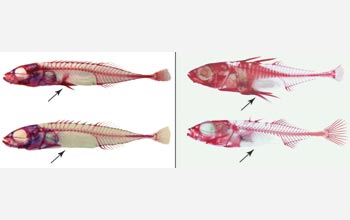News Release 09-120
Different Genes Cause Loss of Body Parts in Similar Fish
Scientists compare how two species of sticklebacks lost pelvises and body armor

The two fish on top have pelvises; the fish on the bottom have evolved differently.
June 4, 2009
This material is available primarily for archival purposes. Telephone numbers or other contact information may be out of date; please see current contact information at media contacts.
New research shows that when two species of stickleback fish evolved and lost their pelvises and body armor, the changes were caused by different genes in each species.
That surprised researchers, who expected the same genes would control the same changes in both related fish.
Results of the study, funded by the National Science Foundation (NSF)'s Divisions of Environmental Biology and Integrative Organismal Systems, are published online today in the journal Current Biology.
"Earth's climate and biosphere are changing rapidly and in unpredictable ways," says Penny Firth, deputy director of NSF's Division of Environmental Biology. "A major challenge for biology is understanding the connections among evolving genomes, evolving populations and changing ecosystems. This research takes an important step by illuminating the genetic basis of evolutionary change in long-separated lineages."
Biologists knew that in many cases of evolution, "the same gene has been used over and over again--even in different species--to result in the same anatomy," says Mike Shapiro, first author of the paper and a biologist at the University of Utah. "What we are finding now is that different genes can have similar effects."
The findings shed new light on how evolution produces diversity in nature, and on the evolution of limb loss--and not just the loss of the pelvis and leg-like pelvic spines in certain sticklebacks.
"Limb loss is something we see in many other groups--snakes, whales, manatees and some amphibians," Shapiro says. "We can't do genetic studies on those animals. Sticklebacks give us insight into what may be going on in many other animal groups."
The study focused on "convergent evolution," which is when the same trait evolves independently in different species or in separate populations of one species. A key question has been whether two species use the same gene or different genes when they evolve the same trait.
Scientists know many cases of the same gene causing two different species to evolve the same trait. The study shows that different genes also can be responsible for evolution of the same traits in two species of stickleback fish.
"Although there is so much diversity in nature, we know very little about the mechanisms that generate that diversity on a genetic level," Shapiro says.
"These fish are increasing diversity within each of their species. It just so happens that both species have found similar solutions to some ecological problem. We found they use different genes to do that, which contradicts earlier research on sticklebacks."
Shapiro conducted the study with three other University of Utah biologists: postdoctoral fellow Jaclyn Aldenhoven, graduate student Christopher Cunningham and undergraduate Ashley Miller.
Stanford University biologist David Kingsley is senior author of the paper, and other co-authors of the paper were Stanford's Brian Summers and Sarita Balabhadra, and evolutionary biologist Michael Bell of Stony Brook University in New York state.
Shapiro and colleagues created the first genome map, or genetic blueprint, for a species named the ninespine stickleback, which has nine spines sticking out of its back and another two extending downward from its pelvis--technically, the pelvic girdle.
The pair of quarter-inch- to half-inch-long belly spines evolved from pelvic fins. Losing the pelvis and its spines is "the equivalent of land animals losing their legs," he says.
The researchers compared the ninespine stickleback's genetic blueprint to the genome of another species they previously studied: the threespine stickleback, which has three larger spines on its back and normally has two spines attached to its pelvis.
Sticklebacks lack scales. Instead, most have body armor that is believed to protect threespine sticklebacks against predatory fish. The armor--made of more than 30 bony plates on each side--extends from just behind the head to the tail on threespine sticklebacks.
In the ninespine fish, there are up to 20 armor plates on each side of the body, typically limited to the tail. Their purpose is not clear.
The study didn't identify specific genes responsible for the evolutionary changes in ninespine sticklebacks, but instead identified places on chromosomes where those genes are located.
The gene responsible for loss of the pelvis in the ninespine stickleback is on chromosome 4, but in the threespine stickleback, the pelvic-loss gene is named Pitx1 and is located on chromosome 7. (The researchers had ruled out the possibility that the Pitx1 gene jumped to chromosome 4 in the ninespine stickleback.)
The gene responsible for changes in the number of body armor plates in the ninespine fish is located on chromosome 12. In the threespine stickleback, the gene is named Eda and is on chromosome 4.
While sex-determination genes are located on chromosome 12 in ninespine sticklebacks, they are located on chromosome 19 in threespine sticklebacks.
"This is very surprising because these species are fairly closely related," even though they diverged 13 million years ago, Shapiro says, noting that "mammals have not changed their sex-determination mechanism in more than 150 million years."
There are six and perhaps eight stickleback species, all in the Northern Hemisphere. They live in Europe; coastal North America north from northern Mexico on the Pacific and north from New York on the Atlantic; and in coastal northern Asia.
Like salmon, many live in the sea and swim upstream to spawn. Others live in lakes.
After Ice Age glaciers began to melt some 15,000 to 20,000 years ago, sea-going sticklebacks swam up streams to newly formed lakes. Many populations of ninespine and threespine sticklebacks were trapped in lakes, creating an experiment in evolution.
"They adapted very quickly and dramatically to these new freshwater environments," says Shapiro. "Some of the changes include shifts in body shape and size, the amount of armor on their bodies and, occasionally, complete loss of major structures like the pelvis. That's the equivalent of us losing our legs."
In the sea, if a larger fish tries to eat it, a stickleback defends itself by extending the spines on its back and pelvis. But the need for pelvic spines changed when the sticklebacks moved into lakes with dragonfly larvae and other aquatic insects but no predatory fish.
"Spines are great when you're trying not to be eaten by a big fish," Shapiro says. "But other predators like dragonfly larvae can grab sticklebacks by the spines, reel them in and eat them. They wait for sticklebacks to swim by and grab them."
So some lake stickleback populations evolved without pelvises and pelvic spines because those without pelvic spines were more likely to survive.
The new study involved mating two ninespine sticklebacks that evolved without pelvises: a male from Point MacKenzie, in Cook Inlet near Anchorage, Alaska, and a female from Fox Holes Lakes near Fort Smith, Northwest Territories, Canada.
"The genetic techniques we use make it necessary to cross-breed animals," says Shapiro. "The techniques we use to identify the genes or regions of the genome that control changes in anatomy are similar to techniques that medical geneticists use to track down genes responsible for cancer and other diseases."
Via test-tube fertilization, "we crossed two sticklebacks with no pelvis, and what we got was [120 offspring], half with a pelvis and half with no pelvis."
Using the offspring's DNA samples, "we made the first map of the ninespine stickleback genome," and then compared the ninespine data to earlier studies of threespine sticklebacks.
For pelvic loss, number of body armor plates and determination of sex, the genes that controlled those traits in ninespine sticklebacks were different than the genes responsible for the same traits in threespine sticklebacks.
Pitx1 controls loss of the pelvis in threespine sticklebacks and is tied to club foot in humans.
Eda regulates the number of body armor plates in threespines and also is mutated in a human disease that involves loss of sweat glands, reduced numbers of teeth and lack of hair, Shapiro says.
-NSF-
-
Biologist Mike Shapiro dons mosquito netting for protection along a lake in Canada.
Credit and Larger Version -
Mike Shapiro cross-breeds stickleback fish in an impromptu field laboratory in Canada.
Credit and Larger Version
Media Contacts
Cheryl Dybas, NSF, (703) 292-7734, email: cdybas@nsf.gov
Lee Siegel, University of Utah, (801) 581-8993, email: leesiegel@ucomm.utah.edu
The U.S. National Science Foundation propels the nation forward by advancing fundamental research in all fields of science and engineering. NSF supports research and people by providing facilities, instruments and funding to support their ingenuity and sustain the U.S. as a global leader in research and innovation. With a fiscal year 2023 budget of $9.5 billion, NSF funds reach all 50 states through grants to nearly 2,000 colleges, universities and institutions. Each year, NSF receives more than 40,000 competitive proposals and makes about 11,000 new awards. Those awards include support for cooperative research with industry, Arctic and Antarctic research and operations, and U.S. participation in international scientific efforts.
Connect with us online
NSF website: nsf.gov
NSF News: nsf.gov/news
For News Media: nsf.gov/news/newsroom
Statistics: nsf.gov/statistics/
Awards database: nsf.gov/awardsearch/
Follow us on social
Twitter: twitter.com/NSF
Facebook: facebook.com/US.NSF
Instagram: instagram.com/nsfgov


